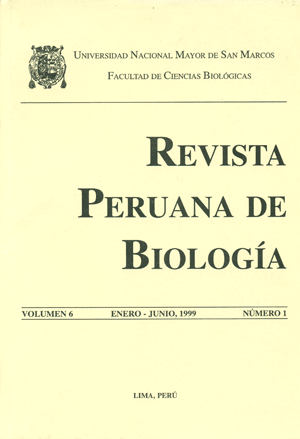Purification and characterization of amino acid oxidase l-snake venom Bothrops Brazili “Jergón Shushupe"
DOI:
https://doi.org/10.15381/rpb.v6i1.8302Keywords:
L-amino acid oxidase, Bothrops brazili, venom, antibacterial, protein.Abstract
An L-aminoacid oxidase was purified from Bothrops brazili snake venom using Sephadex G-100 and CM-Sepahdex C?50 chromatographic method; in both cases 0,1M ammonium acetate pH 6 was used as a eluted. The enzyme was purified 29,3 fold with 30,9% of yield. A homogeneus protein band was achieved by PAGE-SDS, inmunodifusion as well as immunoelectrophoresis. The enzyme was an acid glicoprotein with a molecular weight of 125,7 kd consisting of two subunits of 59,91 kd each, linked by noncovalent bonds. The optimum pH was in the range of 7,5 to 9,0 depending on the L-aminoacid used as substrate. It was a thermoestable protein untill 55 oC, but its activity decreased by alcaline treatment. On the other hand, antibacterial assays using the Grove's method demonstrated that the whole venom as well as its purified enzyme produced a severe action on standardized grown cultures of Staphylococcus aureus, Vibrio cholerae and Streptococcus faecalis.Downloads
Downloads
Published
Issue
Section
License
Copyright (c) 1999 Christian Solís, Enrique Escobar, Armando Yarlequé, Susana Gutiérrez

This work is licensed under a Creative Commons Attribution-NonCommercial-ShareAlike 4.0 International License.
AUTHORS RETAIN THEIR RIGHTS:
a. Authors retain their trade mark rights and patent, and also on any process or procedure described in the article.
b. Authors retain their right to share, copy, distribute, perform and publicly communicate their article (eg, to place their article in an institutional repository or publish it in a book), with an acknowledgment of its initial publication in the Revista Peruana de Biologia.
c. Authors retain theirs right to make a subsequent publication of their work, to use the article or any part thereof (eg a compilation of his papers, lecture notes, thesis, or a book), always indicating its initial publication in the Revista Peruana de Biologia (the originator of the work, journal, volume, number and date).


















